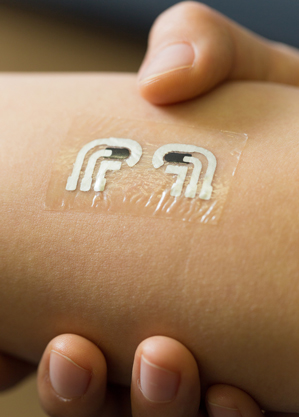What Are the Prospects for Flexible Biosensors?
Flexible, stretchable electronics that could be worn directly on the skin like a temporary tattoo might have a wide range of uses. Such devices might measure vital signs such as respiratory rate, level of electrical activity in the brain, heart rate, temperature, and blood oxygen levels—providing real-time monitoring outside of doctor’s offices, ideally without the wearer even noticing (see “Making Stretchable Electronics and “10 Breakthrough Technologies 2006: Stretchable Silicon”). Here’s an update on how the technology is progressing.

Sensing Tattoo
In 2013 MC10, a startup in Cambridge, Massachusetts, released its first electronic product that could conform to the body—a fitted cap for athletes, known as the Checklight, that senses the severity of impacts to the head. Now, the company is developing a flexible, sticker-like sensor called the Biostamp, which it says can detect data from the brain, muscles, and heart. Many details are still unknown about the product and its exact uses, but a version of the stamp for medical research settings is due to be released this year, says Roozbeh Ghaffari, MC10’s cofounder and vice president of technology. MC10 is working with the biopharmaceutical company UCB and the University of Rochester to develop the Biostamp as a way to monitor patients with movement and neurological disorders. It has also worked with researchers in Korea to develop a patch that help could people with Parkinson’s or other movement disorders by sensing tremors and delivering drugs encapsulated in nanoparticles (see “A Bandage That Senses Tremors, Delivers Drugs, and Keeps a Record”). The Biostamp is based on a design for a sensor that conforms to the skin and performs wireless sensing, outlined in a 2014 paper in Science from the lab of John Rogers, another cofounder and a professor at the University of Illinois. Independently of MC10, Rogers’s lab is working on designs that researchers can use to wirelessly monitor people’s sleeping patterns or check on newborns in intensive care units.
Blood-Test Tattoo
At Northeastern University, associate professor Heather Clark has been developing a tattoo that can be injected into the skin to detect sodium, glucose (see “Tattoo Tracks Sodium and Glucose via an iPhone), and five other markers normally measured during a blood test. The tattoo has tiny sensors that fluoresce in the presence of those substances in the body; the level of fluorescence can be measured by taking a picture of the tattoo with a modified iPhone. In addition, the group has developed a tattoo that detects levels of lithium, which is used to treat bipolar disorder. This could help doctors determine the right dosage of the drug for each patient. So far the group has monitored these levels in mice. These devices have not been tested in humans yet, but Clark says the lab is looking for partners interested in starting clinical trials. That work is detailed in a January article in ACS Nano.
Skin Insights
Cosmetics giant L’Oreal may seem like an unlikely source of electronics breakthroughs, but the company is interested in using thin, flexible, stretchable devices to track changes in the skin over time, says Guive Balooch, global vice president of L’Oreal’s technology incubator. The makeup manufacturer has begun using the devices to measure certain thermal properties of the skin linked to hydration and mechanical properties tied to aging. Although these flexible electronics are only being used for testing for now, Balooch says they could someday make it into a commercial product to help people learn more about their skin. Balooch and other researchers, including Rogers, describe the sensors used to detect the skin’s thermal properties in a 2015 paper in PLOS ONE.
Glucose Sensing
At UC San Diego, researchers in Joseph Wang’s group are working on a temporary tattoo that can take in and measure glucose–a device that could make life easier for diabetes patients. The tattoo was tested on seven healthy volunteers and detected a rise in their glucose levels after they had a meal, according to a December paper in Analytical Chemistry. The idea of continually monitoring glucose is not new—in fact, a product called the GlucoWatch gained regulatory approval in 2001, but it caused skin irritation and was eventually discontinued. To prevent irritation, the researchers covered the electronics in a gel. Wang says the team is making progress on developing and integrating the electronics, but it is unclear when the device will move past a proof of concept. In addition, the group recently showed how a pen filled with inks that react with glucose and other chemicals can draw directly on the body to make a sensor, as shown in this video and described in a February paper in Advanced Healthcare Materials.
The Takeaway:
MC10’s Biostamp technology may reach clinicians by the end of the year, but many other flexible biosensors are still at a conceptual stage and will require more human testing and validation. Fortunately for the developers of such devices, several kinds of flexible electronic components are making intriguing progress (see “A Stretchable, Bendable, and More Powerful Smart-Watch Battery”).
Do you have a big technology question? Send suggestions to questionoftheweek@technologyreview.com
Keep Reading
Most Popular
Large language models can do jaw-dropping things. But nobody knows exactly why.
And that's a problem. Figuring it out is one of the biggest scientific puzzles of our time and a crucial step towards controlling more powerful future models.
The problem with plug-in hybrids? Their drivers.
Plug-in hybrids are often sold as a transition to EVs, but new data from Europe shows we’re still underestimating the emissions they produce.
How scientists traced a mysterious covid case back to six toilets
When wastewater surveillance turns into a hunt for a single infected individual, the ethics get tricky.
Google DeepMind’s new generative model makes Super Mario–like games from scratch
Genie learns how to control games by watching hours and hours of video. It could help train next-gen robots too.
Stay connected
Get the latest updates from
MIT Technology Review
Discover special offers, top stories, upcoming events, and more.